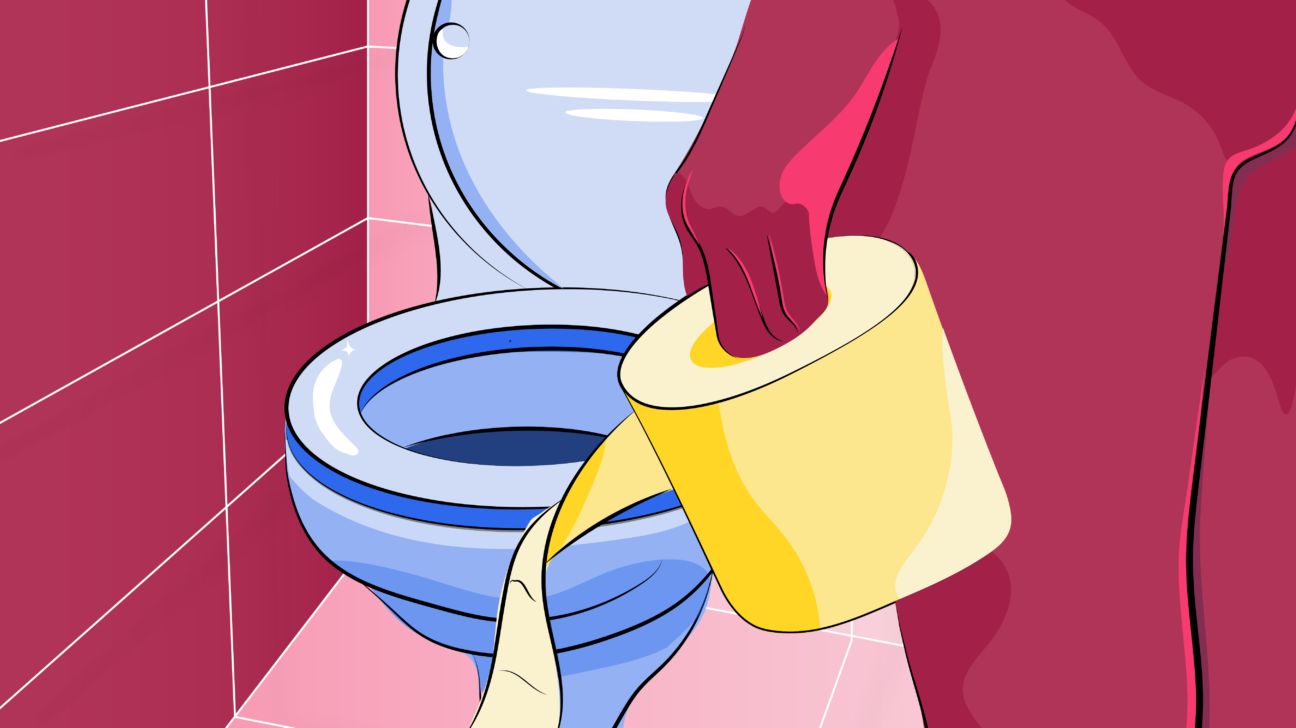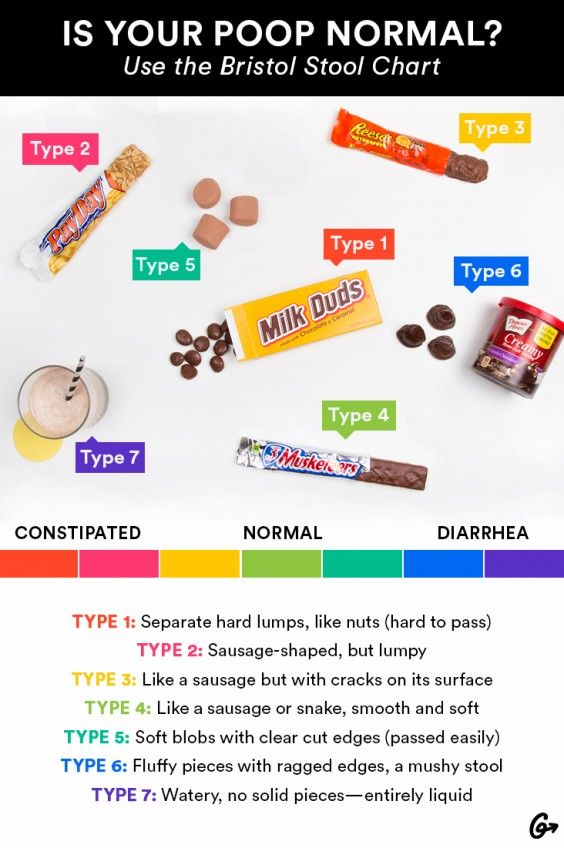Poop. The big brown refund. A-tee-hee-hee. Go ahead, get the laughs out of your system. But trust us, when you struggle getting said poop out of the same system, it could potentially be reeaaally not funny.
So wipe the poop from your butt and the smile from your face, and have a serious think about what that poop could mean for your health.
The cause of intestinal trolling isn’t always clear. It turns out that poop is more than just a (hilarious) punchline — it’s actually an indicator of the work your body is putting in to absorb nutrients, eliminate waste, and keep everything, er, moving.
That might make you wonder: What’s abnormal? What looks/smells/feels off-base? Get ready, because we’re diving right into the toilet bowl, Trainspotting-style, and we’re taking you with us.
When starting out in your career/questionable hobby as a poop detective, the best place to start is with the physical evidence: Exhibit A — poop. Exhibit B — also poop. You get where this is going.
Just like a supervillain’s henchman, your number two can express itself in many ways but could be your downfall if you don’t pay it enough attention.
A helpful tool some gastroenterologists (or digestive experts to you and I) use to categorize poops is the Bristol Stool Chart. It illustrates what you might find before you flush.
Let’s kick off this whistle-stop tour through all things poopy, including how to recognize when something’s up and what to do about unsatisfactory poops.
This chart is unappetizing at best, so we’ve used some candy stand-ins to dial down the ick factor. On second thought, we may just be ruining candy for you. But it’ll help, we promise.
Okay, now you’ve recovered…
As you can see from above, constipation can trigger nut-like lumps and lumpy sausage poops. So you cross both cashews and hot dogs off the grocery list as well as candy. Sorry about all of this.
Types 3 and 5 are within the realm of normal. You’ve got excellent poops, but should maybe take a few nuggets (gross) of wisdom from the “How to have healthier poops” section to prevent your poops from nutty, sausage-y mayhem.
Types 6 and 7 have crossed into diarrhea. Pancakes should be fluffy. Poops should not. And if you’ve entered liquid territory, you definitely need to dispense some TLC towards your poops.
The sweet spot is in the middle: type 4. Soft, S-shaped, and easy to pass, it’s the holy grail of bowel movements. The poop to end all poops.
(This is not strictly true. You will have many, many more poops in your life. We wish you well throughout all of them.)
Disappointment warning: You are never going to poop rainbows. If that’s your plan, I recommend joining the My Little Ponyuniverse. You’re pretty unlikely to experience diarrhea or constipation there.
(Studies on the subject were pretty sparse, so you’ll just have to take our word for it.)
However, not all poop smells are created equal. When poops smell more intense or simply different than usual, this might also point to problems in your poop factory.
How a person interprets smell is completely subjective (we’re pretty sure baby poop smells less horrifying for the people in the room not changing the diaper). So identifying a particular smell is a hard (and, quite frankly, unappealing) way to recognize trouble in Poopytown.
The following symptoms might suggest something’s up, but not necessarily that you need to seek out a doctor’s advice:
- runny poops
- soft poops
- regularly feeling like you have to poop
- pain in your belly or midriff
- sickness and vomiting
- extra farting (just what you needed 🙄)
- bloating
However, if certain symptoms start happening alongside the above, it might be time to talk to someone who knows your ass from your elbow. These include:
- bloody poops
- black poops
- pale poops
- pain in your abdomen
- unexpectedly losing weight
- chills (no, Travolta, they don’t have to be multiplying)
So how can we make all our number twos a number four? Let’s rewind to the beginning of the process.
Seems pretty simple: Eat food, grab nutrients, push poop out of your butt, and flush the rest away.
Well, in this system there are a couple factors at play.
Fiber
The first is fiber, poop’s bae. Doctors lump fiber into two categories: Soluble (meaning it can dissolve in water) or insoluble (meaning that it doesn’t).
Both promote healthy digestion.
Fiber is the helpful assistant who fluffs up the cushions, making them soft and cushy so you’re pooping pretty. It is, in essence, a butt butler. Fiber probably has a cute English accent and answers the door to tell people you’re unavailable, even when you’re not. Fiber is great. Eat more of it.
The Office of Disease Prevention and Health Promotion recommendations vary with age and sex.
However, people should be consuming well above the daily average of the 16 grams most folks in the U.S. get. (Average meaning half of these people are below that number. That’s a one-way ticket to Milk Dud poops.)
Look to fruits, vegetables, legumes, nuts, and whole grains to level up your fiber.
Water
The other big variable is water. Healthy poop is about 75 percent water. Poop is basically pee with an attitude problem.
If the body senses that you’re dehydrated, it’ll suck every drop of moisture out of your food, which means dry, hard poops. Even if you’re getting plenty of fiber, without adequate H2O, you’re sure to get no-fun, hard, painful poops.
Imagine that dehydration is a butler who, instead of fluffing up your pillows, sucks all the water out of your poop. Not particularly useful. Entirely gross. And relatively painful and inconvenient.
And keep in mind that if you’re sweating a bunch due to heat, exertion, or coming up with excuses to your significant other as to why you’ll be home late, you’ll need even more water to return normal hydration levels.
The National Academies of Sciences, Engineering, and Medicine determined that an adequate daily fluid intake for a healthy adult living in a temperate climate is:
- about 15.5 cups (3.7 liters) of fluids for men
- about 11.5 cups (2.7 liters) of fluids for women
Follow their advice for smooth poops. They know their business.
Constipation can happen when you short-change either fiber or water in the body. Researchers in 2016 also suggested that constipation is a common side effect of high-protein diets, so don’t confuse “Paleo” with “meat-tastic” and forget to load up on veggies and H2O!
Once you’ve got constipation running smoothly, you have to think about the other end of what happens at the other end: Diarrhea. Usually it’s the result of your body hitting the “eject” button on whatever doesn’t agree with your system. (Fried, fatty foods are a usual suspect. Dairy, fructose, and artificial sweeteners can also tenderize your butt.)
Viruses or other illnesses are also notorious poop-liquefiers, as well as certain medications.
If you find yourself ping-ponging between the two extremes, you might have irritable bowel syndrome (IBS). Be sure to visit the doctor if your symptoms don’t seem to clear up after simplifying your diet.
OK, you’ve tackled the usual suspects of water and fiber. Are there any other poop hacks you can put in place to become the world’s greatest pooper?
Probiotics
These helpful microorganisms contribute to the “good” bacteria in your body.
Yes, probiotics are the buzzword du jour, but people have been chowing down on fermented foods for centuries and surely contributed to some historically healthy poops. They pooped like mavericks before it was cool.
Like worker bees, the busy bacteria in your digestive system help break down your food and give you a boost when it comes to pooping. (Bonus, they do a world of good for the rest of your body too.)
Keep in mind, however, not all probiotics are created equal.
And if only pills and yogurt come to mind when thinking about probiotics, it’s time to meet kefir, kombucha, and kimchi. But plenty of other foods can boost your gut bacteria, such as sauerkraut, tempeh, and miso soup, to name just a few.
Exercise
Another way to deal with poop-related woes? Busting a sweat. Regular exercise won’t just give you a shapely booty, it’ll also help that booty run smoothly on the inside. Those hips don’t lie, and neither does your poop.
However, other researchers aren’t quite as convinced that doing crunches will make your poop less crunchy. A 2012 article suggests that no data supports the idea that exercise makes chronic constipation any easier.
Short-term boosts in activity may hurry your poops along at a clipped pace through the body and prevent it from drying out or stopping up your system. Up yours, poop.
Cop a squat
Some experts debate that modern toilets put unnecessary strain on your body’s bowels. Squatting is arguably a more natural stance for number two. Toilets are, ironically, a little bit crap.
Not that you need to forgo your toilet altogether, leave modern society, move to the woods, and grow a mountain-man beard (although, the way things are at present, it may not be the worst shout.)
Simply propping your feet up on a stool or a stack of books will improve the angle of your toilet time. Consider this your invitation to kick up your heels in the bathroom and poop with reckless abandon.
We understand not wanting to get all that close to your poop. However, taking a closer look or at least being more conscious about how they feel can help you spot health problems early and get the jump on them.
Make sure you’re eating plenty of foods that have fiber and drinking all the water. Keep active, pull off the dopest toilet squats you can, and basically have an absolute blast while you’re pooping.
Checking out probiotics may also perk up your poops. There’s a bunch available for purchase online.
This article was brought to you by the word poop, which features 137 times.



